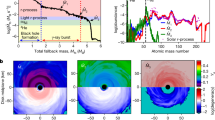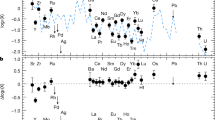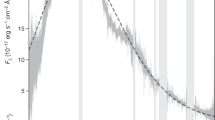Abstract
A growing body of evidence indicates that binary neutron-star mergers are the primary origin of heavy elements produced exclusively through rapid neutron capture1,2,3,4 (the ‘r-process’). As neutron-star mergers occur infrequently, their deposition of radioactive isotopes into the pre-solar nebula could have been dominated by a few nearby events. Although short-lived r-process isotopes—with half-lives shorter than 100 million years—are no longer present in the Solar System, their abundances in the early Solar System are known because their daughter products were preserved in high-temperature condensates found in meteorites5. Here we report that abundances of short-lived r-process isotopes in the early Solar System point to their origin in neutron-star mergers, and indicate substantial deposition by a single nearby merger event. By comparing numerical simulations with the early Solar System abundance ratios of actinides produced exclusively through the r-process, we constrain the rate of occurrence of their Galactic production sites to within about 1−100 per million years. This is consistent with observational estimates of neutron-star merger rates6,7,8, but rules out supernovae and stellar sources. We further find that there was probably a single nearby merger that produced much of the curium and a substantial fraction of the plutonium present in the early Solar System. Such an event may have occurred about 300 parsecs away from the pre-solar nebula, approximately 80 million years before the formation of the Solar System.
This is a preview of subscription content, access via your institution
Access options
Access Nature and 54 other Nature Portfolio journals
Get Nature+, our best-value online-access subscription
$29.99 / 30 days
cancel any time
Subscribe to this journal
Receive 51 print issues and online access
$199.00 per year
only $3.90 per issue
Buy this article
- Purchase on Springer Link
- Instant access to full article PDF
Prices may be subject to local taxes which are calculated during checkout



Similar content being viewed by others
Data availability
The datasets generated during and/or analysed during the current study are available in the Zenodo repository, https://doi.org/10.5281/zenodo.2556447. Source Data for Figs. 2 and 3 are provided with the paper.
Code availability
The computer code that was used for the calculations is available from the corresponding author upon reasonable request.
References
Goriely, S., Bauswein, A. & Janka, H.-T. r-process nucleosynthesis in dynamically ejected matter of neutron star mergers. Astrophys. J. 738, L32 (2011).
Abbott, B. P. et al. Multi-messenger observations of a binary neutron star merger. Astrophys. J. 848, L12 (2017).
Hotokezaka, K., Piran, T. & Paul, M. Short-lived 244Pu points to compact binary mergers as sites for heavy r-process nucleosynthesis. Nat. Phys. 11, 1042 (2015).
Côté, B. et al. The origin of r-process elements in the Milky Way. Astrophys. J. 855, 99 (2018).
Tissot, F. L. H., Dauphas, N. & Grossman, L. Origin of uranium isotope variations in early solar nebula condensates. Sci. Adv. 2, e1501400 (2016).
Wanderman, D. & Piran, T. The rate, luminosity function and time delay of non-collapsar short GRBs. Mon. Not. R. Astron. Soc. 448, 3026–3037 (2015).
Abbott, B. P. et al. GWTC-1: a gravitational-wave transient catalog of compact binary mergers observed by LIGO and Virgo during the first and second observing runs. Preprint at http://arxiv.org/abs/1811.12907 (2018).
Gupte, N. & Bartos, I. Observational consequences of structured jets from neutron star mergers in the local Universe. Preprint at http://arxiv.org/abs/1808.06238 (2018).
Abadie, J. et al. Topical review: predictions for the rates of compact binary coalescences observable by ground-based gravitational-wave detectors. Class. Quantum Gravity 27, 173001 (2010).
Wasserburg, G. J., Busso, M., Gallino, R. & Nollett, K. M. Short-lived nuclei in the early Solar System: possible AGB sources. Nucl. Phys. A 777, 5–69 (2006).
McMillan, P. J. Mass models of the Milky Way. Mon. Not. R. Astron. Soc. 414, 2446–2457 (2011).
Montmerle, T. et al. 3. Solar System formation and early evolution: the first 100 million years. Earth Moon Planets 98, 39–95 (2006).
Tang, H., Liu, M.-C., McKeegan, K. D., Tissot, F. L. H. & Dauphas, N. In situ isotopic studies of the U-depleted Allende CAI Curious Marie: pre-accretionary alteration and the co-existence of 26Al and 36Cl in the early solar nebula. Geochim. Cosmochim. Acta 207, 1–18 (2017).
Dauphas, N. & Chaussidon, M. A perspective from extinct radionuclides on a young stellar object: the Sun and its accretion disk. Annu. Rev. Earth Planet. Sci. 39, 351–386 (2011).
Cappellaro, E., Evans, R. & Turatto, M. A new determination of supernova rates and a comparison with indicators for galactic star formation. Astron. Astrophys. 351, 459–466 (1999).
Lugaro, M., Ott, U. & Kereszturi, A. Radioactive nuclei from cosmochronology to habitability. Prog. Part. Nucl. Phys. 102, 1–47 (2018).
Kopparapu, R. K. et al. Host galaxies catalog used in LIGO searches for compact binary coalescence events. Astrophys. J. 675, 1459–1467 (2008).
Fong, W., Berger, E., Margutti, R. & Zauderer, B. A. A decade of short-duration gamma-ray burst broadband afterglows: energetics, circumburst densities, and jet opening angles. Astrophys. J. 815, 102 (2015).
Berger, E. Short-duration gamma-ray bursts. Annu. Rev. Astron. Astrophys. 52, 43–105 (2014).
Siegel, D. M., Barnes, J. & Metzger, B. D. The neutron star merger GW170817 points to collapsars as the main r-process source. Preprint at http://arxiv.org/abs/1810.00098 (2018).
Tauris, T. M. & van den Heuvel, E. P. J. in Compact Stellar X-ray Sources (eds Lewin, W. & van der Klis, M.) 623–665 (Cambridge Univ. Press, Cambridge, 2006).
Metzger, B. D. Kilonovae. Living Rev. Relativ. 20, 3 (2017).
Cowperthwaite, P. S. et al. The electromagnetic counterpart of the binary neutron star merger LIGO/Virgo GW170817. II. UV, optical, and near-infrared light curves and comparison to kilonova models. Astrophys. J. 848, L17 (2017).
Truran, J. W. The age of the universe from nuclear chronometers. Proc. Natl Acad. Sci. USA 95, 18–21 (1998).
Yang, C.-C. & Krumholz, M. Thermal-instability-driven turbulent mixing in galactic disks. I. Effective mixing of metals. Astrophys. J. 758, 48 (2012).
Acknowledgements
We are grateful to S. Goldstein, D. Helfand, T. Huard, Z. Marka, P. Mueller, C. Scharf and W. Zajc for their valuable comments and suggestions. We also thank the University of Florida and Columbia University in the City of New York for their generous support.
Author information
Authors and Affiliations
Contributions
I.B. and S.M. contributed to the origination of the idea for the project and worked out the general details collaboratively. I.B. carried out the calculations.
Corresponding author
Ethics declarations
Competing interests
The authors declare no competing interests.
Additional information
Publisher’s note: Springer Nature remains neutral with regard to jurisdictional claims in published maps and institutional affiliations.
Extended data tables
Source data
Rights and permissions
About this article
Cite this article
Bartos, I., Marka, S. A nearby neutron-star merger explains the actinide abundances in the early Solar System. Nature 569, 85–88 (2019). https://doi.org/10.1038/s41586-019-1113-7
Received:
Accepted:
Published:
Issue Date:
DOI: https://doi.org/10.1038/s41586-019-1113-7
This article is cited by
-
r-Process nucleosynthesis in gravitational-wave and other explosive astrophysical events
Nature Reviews Physics (2022)
-
The production of actinides in neutron star mergers
AAPPS Bulletin (2022)
-
The periodic table and the physics that drives it
Nature Reviews Chemistry (2020)
-
Neutron star mergers and how to study them
Living Reviews in Relativity (2020)
-
On the Distribution and Variation of Radioactive Heat Producing Elements Within Meteorites, the Earth, and Planets
Space Science Reviews (2020)
Comments
By submitting a comment you agree to abide by our Terms and Community Guidelines. If you find something abusive or that does not comply with our terms or guidelines please flag it as inappropriate.



